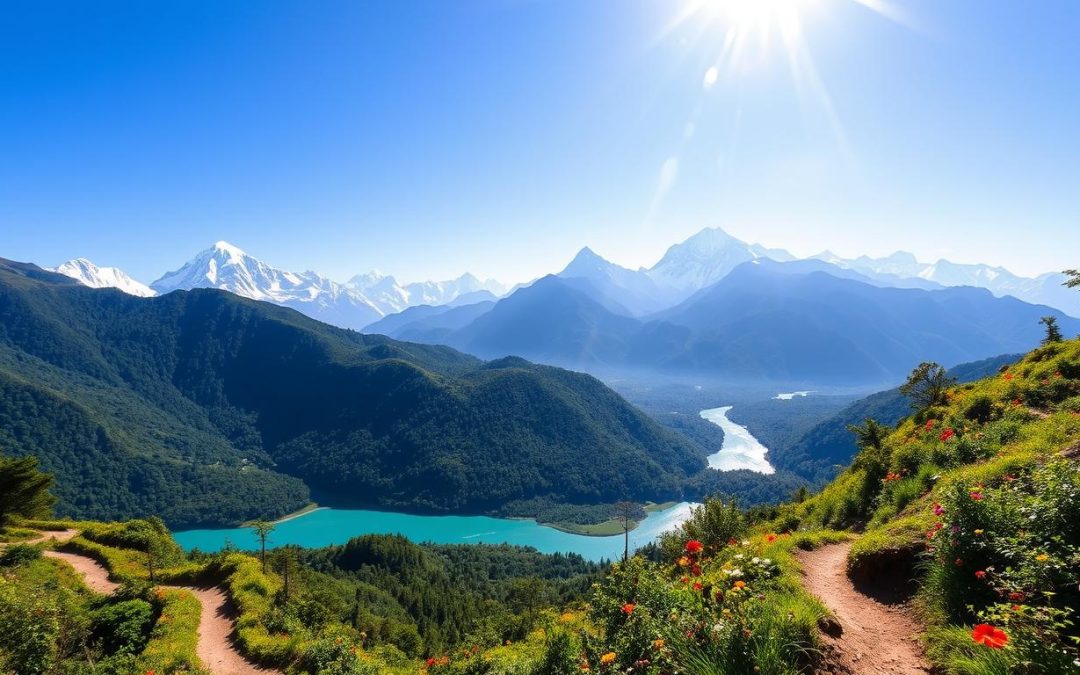Have you ever wondered how to plan a trip that perfectly aligns with the weather? Choosing the right season can make or break your adventure, especially in a place as diverse as Nepal. From the towering Himalayas to the lush lowlands, this country offers a range of experiences that vary greatly with the time of year.
Understanding the climatic diversity is key. The high-altitude regions are ideal for trekking, while the lower areas are perfect for cultural excursions and wildlife spotting. Each season brings its own unique charm and challenges.
In this article, we’ll explore the best time to visit Nepal, focusing on seasonal advantages, trekking tips, and cultural insights. Whether you’re planning a mountain trek or a lowland adventure, we’ve got you covered.
Key Takeaways
- Nepal’s diverse regions offer unique experiences based on the season.
- Choosing the right time is crucial for a fulfilling trip.
- High-altitude trekking is best during specific months.
- Cultural excursions are ideal in the lower regions.
- Understanding regional weather variations enhances your travel experience.
Understanding Nepal’s Diverse Climate
Exploring a country with varied landscapes means adapting to its weather. The climate here is divided into four distinct regions, each offering unique experiences. From the hot, humid plains to the chilly mountain peaks, understanding these differences is key to planning your journey.
Regional Weather Variations: Terai, Hills, and Himalayas
The Terai region, located in the southern plains, experiences hot and humid conditions. Temperatures often exceed 95°F, especially between March and October. Despite the heat, this area is known for its lush greenery and wildlife, making it a scenic destination.
In contrast, the hill regions, including Kathmandu and Pokhara, enjoy moderate temperatures. Kathmandu, at 4,600 feet, sees daytime highs around 77°F in October, while nights can drop to 32°F. These areas are perfect for cultural excursions and leisurely walks.
The Himalayan regions are much colder, with high altitudes leading to freezing temperatures and snowfall. Lukla, a popular trekking gateway at 9,400 feet, can be as cold as 50°F even in October. These conditions make high-altitude treks both challenging and rewarding.
How Altitude Impacts Your Experience
Altitude plays a significant role in shaping your travel experience. Higher elevations mean cooler temperatures and thinner air, which can affect your stamina. For example, a trek in the Himalayas requires preparation for sudden weather changes and potential snowfall.
Seasonal changes also impact daily weather. The monsoon season, from mid-June to September, brings heavy rainfall and high humidity. This can make travel difficult, especially in lower regions. On the other hand, spring and autumn offer sunny days and mild temperatures, ideal for outdoor activities.
Understanding these variations ensures you’re well-prepared for your adventure. Whether you’re trekking in the mountains or exploring the plains, knowing the climate helps you make the most of your time.
Choosing the Ideal Season for Your Visit
Timing your visit can transform your travel experience from good to unforgettable. Each season offers unique opportunities, whether you’re trekking in the mountains or exploring cultural landmarks. Understanding the characteristics of each period helps you plan a trip that aligns with your goals.
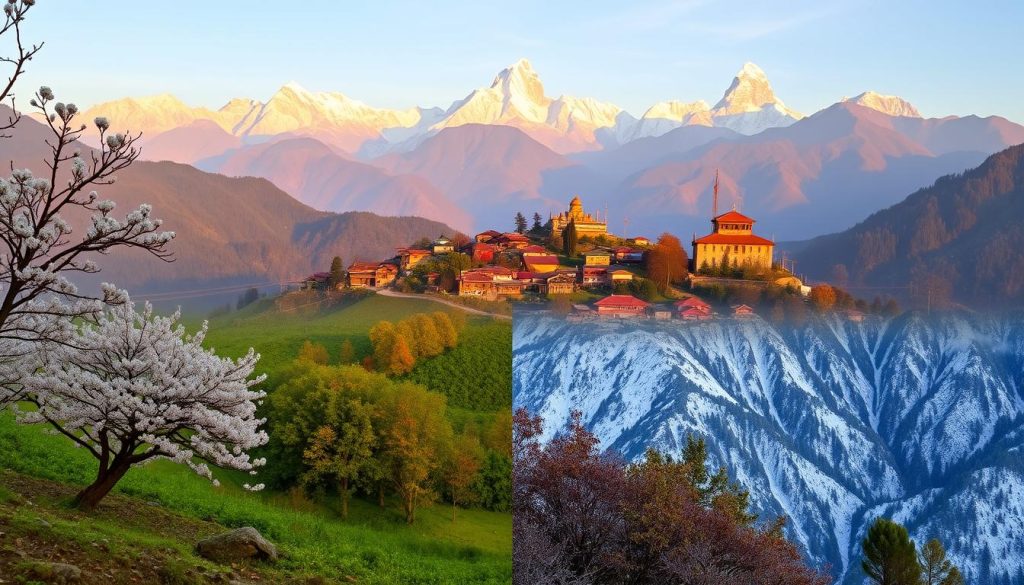
Seasonal Overviews and Key Considerations
Autumn, from September to November, is a favorite among trekkers. The weather is stable, with daytime temperatures around 84°F and cooler nights. This season provides clear skies, making it perfect for mountain views and outdoor activities. Festivals like Dashain and Tihar add cultural richness to your journey.
Spring, from March to May, is another excellent time to visit. Temperatures range from 65°F to 91°F, creating ideal conditions for trekking and wildlife spotting. The blooming wildflowers and vibrant festivals, such as Holi, make this season particularly appealing.
Winter, from December to February, is less crowded and budget-friendly. While high-altitude treks can be challenging due to cold temperatures, lower regions like Kathmandu and Pokhara are great for cultural tours. The crisp air and clear skies offer stunning views of the Himalayas.
Monsoon season, from June to September, brings heavy rainfall and high humidity. While trekking is less favorable, this period is ideal for exploring lush landscapes and enjoying fewer crowds. Be prepared for occasional travel disruptions due to rain.
- Autumn: Stable weather, clear skies, and cultural festivals.
- Spring: Mild temperatures, blooming nature, and vibrant celebrations.
- Winter: Fewer crowds, budget-friendly, and crisp conditions.
- Monsoon: Lush greenery, fewer tourists, and occasional rain.
When planning your trip, consider your priorities. If trekking is your focus, autumn and spring are ideal. For a quieter, budget-friendly experience, winter is a great choice. Monsoon season offers unique beauty but requires flexibility due to weather changes.
Nepal: Best Months for a Weather-Savvy Trip: A Seasonal Breakdown
Planning your journey around the weather can make all the difference in your travel experience. Each month brings unique conditions, from clear skies to heavy rainfall, directly impacting your adventures. Here’s a detailed breakdown to help you choose the right time for your trip.
Weather Conditions by Month
Understanding monthly weather trends ensures you’re prepared for your adventure. Here’s what to expect throughout the year:
| Month | Temperature (°F) | Precipitation | Daylight Hours | Travel Tips |
|---|---|---|---|---|
| January | 32-59 | Low | 10-11 | Ideal for cultural tours in Kathmandu; chilly in the mountains. |
| February | 36-64 | Low | 11-12 | Great for moderate treks; fewer crowds. |
| March | 41-73 | Moderate | 12-13 | Spring blooms make trails scenic; perfect for wildlife spotting. |
| April | 50-81 | Moderate | 13-14 | Warm days and clear skies; ideal for high-altitude treks. |
| May | 59-86 | High | 14-15 | Pre-monsoon showers; prepare for sudden weather changes. |
| June | 64-86 | Very High | 14-15 | Monsoon begins; trails may be slippery; fewer tourists. |
| July | 64-84 | Very High | 14-15 | Heavy rainfall; focus on cultural activities in lower regions. |
| August | 64-84 | Very High | 13-14 | Rain continues; lush landscapes but limited trekking options. |
| September | 63-82 | High | 12-13 | Monsoon tapers off; trails begin to dry; fewer crowds. |
| October | 55-77 | Low | 11-12 | Peak trekking season; clear skies and stable weather. |
| November | 46-68 | Low | 10-11 | Cooler days; ideal for high-altitude adventures. |
| December | 36-59 | Low | 10-11 | Chilly but clear; great for cultural tours and mild treks. |
Each month offers unique opportunities. For example, October and November are perfect for high-altitude treks with clear skies. March and April bring blooming landscapes, ideal for scenic trails. Monsoon months, while wet, offer lush greenery and fewer tourists.
In Kathmandu, temperatures remain moderate year-round, making it a great base for cultural excursions. Whether you’re trekking or exploring, understanding these patterns ensures a fulfilling trip.
Planning Your Trek: Tips for Weather-Optimized Journeys
Mastering the art of trekking means understanding how to navigate seasonal challenges. Whether you’re heading to Everest Base Camp or exploring lower trails, the right preparation can make all the difference. From gear selection to managing altitude, here’s how to optimize your journey for any time of year.
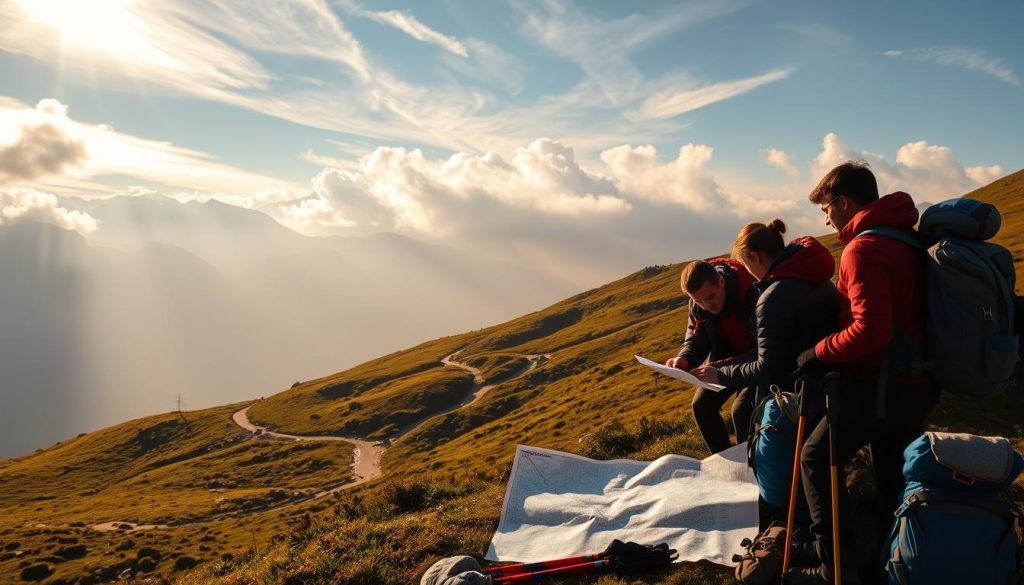
Gear Up for Seasonal Changes
Your gear is your first line of defense against the elements. In winter, focus on warmth with insulated jackets, thermal layers, and waterproof boots. For the monsoon season, prioritize quick-drying clothing and sturdy, slip-resistant footwear. Layering is key—it allows you to adapt to sudden temperature swings, especially at higher altitudes.
Don’t forget essentials like a reliable backpack, a high-quality sleeping bag, and trekking poles. These items can significantly enhance your comfort and safety. Research your destination’s specific needs and invest in gear that’s tested for tough conditions.
Managing High Altitude and Temperature Swings
High-altitude treks, such as those to Everest Base Camp, require extra preparation. The air is thinner, and temperatures can drop drastically, even in warmer months. Acclimatization is crucial—take rest days to let your body adjust and avoid altitude sickness.
Layering is your best friend. Start with a moisture-wicking base layer, add an insulating mid-layer, and finish with a windproof outer shell. This setup keeps you warm during chilly mornings and allows you to shed layers as the day heats up.
Be prepared for sudden weather changes. Pack a lightweight rain jacket, even if rain isn’t forecasted. At high altitudes, conditions can shift rapidly, and staying dry is essential for maintaining body heat.
Finally, plan your trek carefully. Check weather forecasts and trail conditions before you go. Book accommodations in advance, especially during peak seasons. With the right preparation, you’ll be ready to tackle any challenge the mountains throw your way.
Exploring Nepal’s Terai, Hills, and Himalayan Regions
Discovering the diverse landscapes of Nepal means adapting to its unique weather patterns. From the lush jungles of the Terai to the rugged trails of the Himalayas, each region offers a distinct experience. Understanding these differences ensures you’re prepared for your adventure.
Adapting to Different Landscapes
The Terai region, with its hot and humid climate, is a paradise for wildlife enthusiasts. Temperatures often soar above 95°F, especially between March and October. Despite the heat, the lush greenery and vibrant wildlife make it a must-visit area.
In contrast, the hill regions, including Kathmandu and Pokhara, enjoy moderate temperatures. Kathmandu, at 4,600 feet, sees daytime highs around 77°F in October, while nights can drop to 32°F. These areas are perfect for cultural excursions and leisurely walks.
The Himalayan regions are much colder, with high altitudes leading to freezing temperatures and snowfall. Lukla, a popular trekking gateway at 9,400 feet, can be as cold as 50°F even in October. These conditions make high-altitude treks both challenging and rewarding.
Famous trekking areas like Annapurna and Everest offer unique weather patterns. The Annapurna Base Camp, at 3,700 meters, is known for its scenic trails and blooming wildflowers. The Everest region, on the other hand, is famous for its breathtaking views and challenging treks.
Mustang, located in the rainshadow of the Himalayas, experiences much drier conditions. This unique weather pattern makes it ideal for trekking during the monsoon season. Regional festivals add cultural flavor to your journey, making it a memorable experience.
Transitioning smoothly from one area to another requires careful planning. Be prepared for sudden weather changes and adapt your trekking strategies accordingly. Whether you’re exploring the Terai or trekking in the Himalayas, understanding these variations ensures a fulfilling adventure.
Spring in Nepal: Floral Beauty and Cultural Vibes
Spring brings a magical transformation to the landscapes, making it a favorite season for many travelers. From blooming wildflowers to vibrant festivals, this time of year offers a perfect blend of natural beauty and cultural richness. Whether you’re trekking through scenic trails or immersing yourself in local celebrations, spring promises an unforgettable experience.
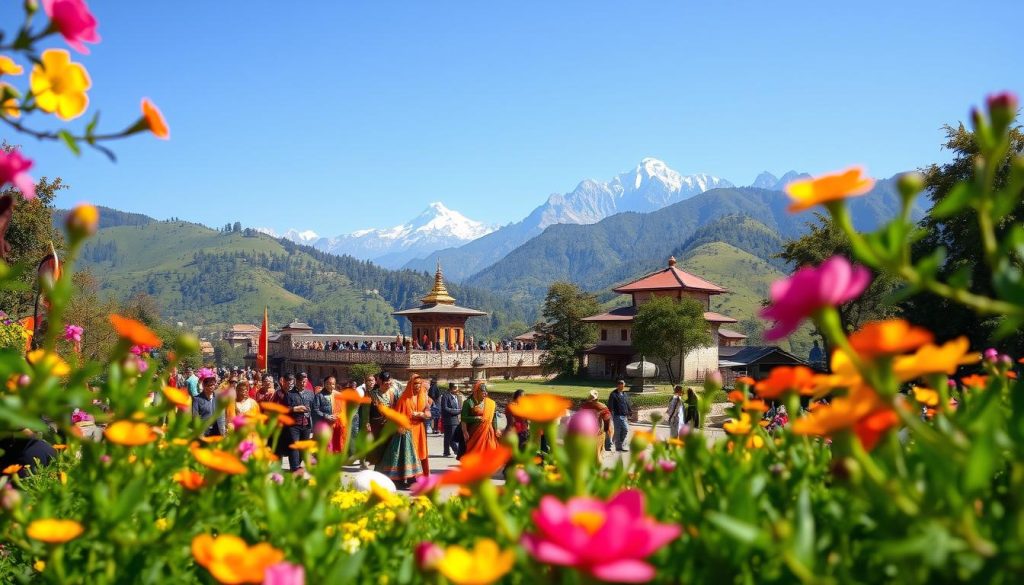
Witnessing Blooming Wildflowers and Festivals
As the snow melts, the trails come alive with bursts of color. Wildflowers blanket the lower and mid-altitude regions, creating a picturesque setting for your adventures. March and April are particularly stunning, with rhododendrons and other blooms adding vibrancy to the scenery.
Spring is also a time of celebration. Festivals like Holi and Lhosar bring communities together, offering a glimpse into the region’s rich cultural heritage. These events are filled with music, dance, and traditional rituals, making them a highlight of your travel experience.
Weather Advantages for Trekkers
The mild weather during spring makes it ideal for trekking. Daytime temperatures range from 65°F to 91°F, providing comfortable conditions for outdoor activities. Unlike the peak autumn season, spring offers fewer crowds on popular trails, allowing you to enjoy the serenity of nature.
High-altitude treks are especially rewarding during this time. The clear skies and stable weather provide breathtaking views of the Himalayas. Whether you’re exploring the Annapurna Circuit or trekking to Everest Base Camp, spring ensures a memorable journey.
Plan your itinerary to capture the best of both worlds. Combine scenic hikes with cultural excursions to fully experience the charm of spring. With its perfect balance of natural beauty and festive vibes, this season is a must for any adventurer.
Autumn Adventures: Peak Season Exploration
Autumn in Nepal is a time of clarity and adventure, offering the perfect blend of weather and cultural richness. From late September to November, the skies are clear, and the landscapes are vibrant, making it the ideal season for trekking and sightseeing. Whether you’re heading to base camp or exploring the lower regions, autumn promises an unforgettable experience.
Ideal Conditions for Sightseeing and Trekking
One of the highlights of autumn is the clear weather, which reveals breathtaking views of the Himalaya. The crisp air and stable temperatures make it a good time for extended treks. Cooler evenings are a bonus, allowing you to enjoy the scenery without the midday heat.
Cultural festivals like Dashain and Tihar add vibrancy to this season. Celebrated in Kathmandu and across the country, these events showcase local traditions and bring communities together. It’s a good opportunity to immerse yourself in the culture while enjoying the ideal weather.
Navigating peak season crowds can be challenging, but with some planning, you can make the most of your trip. Book accommodations and permits early to avoid last-minute hassles. Popular trails like the base camp routes can get busy, so consider starting your trek early in the day.
Autumn’s weather is a stark contrast to the monsoon season. The trails are dry, and the skies are clear, making it easier to explore. Whether you’re trekking in the Himalaya or sightseeing in the lower regions, autumn ensures a smooth and enjoyable journey.
Plan your itinerary to include both outdoor adventures and cultural experiences. This balance will give you a well-rounded view of the country. With its clear skies, vibrant landscapes, and festive atmosphere, autumn is truly the best time to explore Nepal.
Winter Wonders: Lower Crowds and Crisp Conditions
Winter in Nepal offers a serene escape with fewer crowds and crisp, clear skies. This season transforms the landscapes into a peaceful wonderland, ideal for exploration. Whether you’re a seasoned traveler or a first-time visitor, winter provides unique opportunities to experience the country’s beauty in a quieter, more intimate way.
Sightseeing and Mild Trekking Options
Winter is perfect for sightseeing and lower-altitude hikes. While high mountain treks like Everest Base Camp may be challenging due to snow, regions like Kathmandu and Pokhara remain accessible. Daytime temperatures in these areas hover around 59°F, making it comfortable for outdoor activities.
Popular attractions include:
- Kathmandu’s cultural sites, such as Swayambhunath and Pashupatinath.
- Chitwan National Park, where wildlife spotting is easier due to reduced vegetation.
- Scenic trails in the Annapurna foothills, offering breathtaking views without the crowds.
Clear winter days also provide excellent photographic opportunities, with snow-capped peaks serving as a stunning backdrop.
How to Stay Warm During Your Trip
Staying warm is key to enjoying your winter adventure. Layering is essential—start with a moisture-wicking base layer, add an insulating mid-layer, and finish with a windproof outer shell. Don’t forget accessories like gloves, a warm hat, and thermal socks.
Here are a few tips:
- Pack a high-quality sleeping bag rated for cold temperatures.
- Use hand warmers for extra comfort during chilly mornings.
- Stay hydrated and consume warm beverages to maintain body heat.
With the right preparation, you can enjoy a cozy yet adventurous winter trip.
Winter also brings budget-friendly deals on accommodations and permits. Fewer travelers mean more personalized experiences and easier access to popular sites. Whether you’re exploring cultural landmarks or hiking scenic trails, winter is a month of discovery and tranquility.
Navigating the Monsoon: Pros and Cons for Adventurers
The monsoon season transforms the landscape into a lush, vibrant paradise, but it also brings unique challenges. From heavy rain to slippery trails, this time of year requires careful planning. Yet, it also offers hidden benefits, like fewer crowds and discounted rates.
Mitigating the Challenges of Heavy Rainfall
Monsoon rain can significantly impact your travel plans. Roads may become muddy and difficult to navigate, while trekking trails can turn slippery. Flight schedules are often disrupted, so flexibility is key. Here’s how to prepare:
- Gear Up: Invest in waterproof clothing, sturdy boots, and a reliable rain jacket. Quick-drying materials are essential for comfort.
- Plan Alternatives: Have indoor activities ready, such as exploring cultural sites or museums, in case outdoor plans fall through.
- Stay Informed: Check weather forecasts regularly and adjust your itinerary as needed.
Certain areas, like Mustang, remain accessible during the monsoon due to their location in the rainshadow. These regions offer a unique escape from the heavy rain and are perfect for trekking or cultural tours.
The monsoon typically lasts from June to September, with april and May serving as transition months. During this period, you can expect consistent rain, but also lush greenery and fewer tourists. Accommodation rates are often lower, making it a budget-friendly option.
Here are some pros and cons to consider:
- Pros:
– Lush, vibrant landscapes.
– Fewer crowds and discounted rates.
– Unique activities like white water rafting. - Cons:
– Slippery trails and challenging road conditions.
– Flight delays and cancellations.
– Limited access to high-altitude treks.
By planning ahead and staying flexible, you can make the most of the monsoon season. Whether you’re exploring the lower regions or venturing into the rainshadow, this time of year offers a unique perspective on the base of natural beauty and cultural richness.
Outdoor Activities and Festivals Across the Seasons
From cultural celebrations to adrenaline-pumping sports, there’s always something exciting to do. Each season offers unique opportunities to immerse yourself in local traditions and thrilling adventures. Whether you’re a culture enthusiast or an adventure seeker, you’ll find plenty to enjoy.
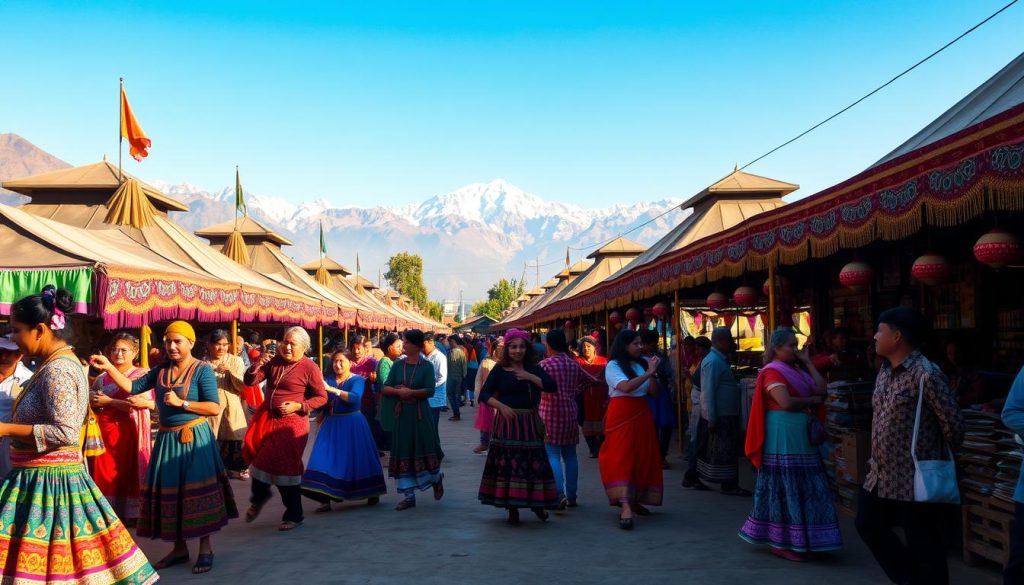
Unique Cultural Events and Local Celebrations
Festivals are a big thing here, and they happen all year round. In February and March, the Pokhara Street Festival brings the city to life with music, dance, and local crafts. Tamu Losar, celebrated by the Gurung community, is another vibrant event filled with traditional rituals and feasts.
During autumn, Dashain and Tihar take center stage. These festivals are marked by family gatherings, colorful decorations, and religious ceremonies. Participating in these events gives you a deeper understanding of the local culture.
Adventure Sports: Rafting, Paragliding, and More
If you’re into adventure, you’re in for a treat. White-water rafting is a lot of fun, especially after the monsoon season in September and October. The rivers are at their peak, offering thrilling rapids and scenic views.
Paragliding in Pokhara is another must-try activity. The clear skies and steady winds during February and March make it the perfect time to soar above the city and enjoy breathtaking views of the Himalayas.
For those who prefer land-based adventures, trekking is a great thing to do in spring and autumn. The trails are dry, and the weather is mild, making it ideal for long hikes.
Planning your trip around these activities can make your experience even better. Here are a few tips:
- Book accommodations and permits early, especially during peak seasons.
- Check weather forecasts to ensure optimal conditions for outdoor activities.
- Balance your itinerary with both cultural and adventure experiences.
No matter when you visit, there’s always something exciting to do. From vibrant festivals to thrilling sports, every season offers unique opportunities to explore and enjoy.
Insider Tips for a Weather-Savvy Trip to Nepal
Planning a trip that aligns with the weather requires insider knowledge and preparation. From booking flights to securing accommodations, a little foresight can make your journey smoother and more enjoyable. Here’s how to navigate the logistics like a pro.
Booking, Accommodations, and Local Help
Booking flights 6-8 weeks in advance ensures availability, especially during peak seasons like october and november. Local travel agencies can assist with permits, guides, and transportation, saving you time and effort. Guesthouses often offer budget-friendly deals during off-peak periods.
For accommodations, flexibility is key. During festivals or high-demand months, prices can spike. Consider staying in smaller towns or booking early to secure the best rates. Local guesthouses often provide personalized service and insider tips for your planning trip.
Weather fluctuations can impact your itinerary. Pack layers for sudden temperature changes and always carry a rain jacket, even in dry seasons. Local transportation, like buses or shared taxis, is affordable but can be unpredictable. Plan for delays and have backup options.
| Tip | Details |
|---|---|
| Book Early | Secure flights and accommodations 6-8 weeks in advance, especially for october and november. |
| Local Assistance | Use travel agencies for permits, guides, and transportation. |
| Flexible Accommodations | Stay in smaller towns or book early to avoid high prices during peak seasons. |
| Weather Preparedness | Pack layers and a rain jacket for sudden changes. |
| Transportation Backup | Plan for delays and have alternative travel options. |
Balancing cost with comfort is essential. During festivals, prioritize experiences over luxury. Pre-planned itineraries help manage weather-driven uncertainties, ensuring a stress-free planning trip. With these tips, you’ll be ready to tackle any challenge and make the most of your adventure.
Conclusion
Understanding seasonal weather patterns is the key to unlocking a seamless travel experience. By planning around diverse conditions, you can maximize your adventure and avoid unexpected challenges. Whether you’re trekking in the mountains or exploring cultural sites, timing your visit ensures you make the most of your journey.
Use the detailed forecasts and insider tips shared in this article to schedule your trip. Flexibility is essential, especially when navigating weather-driven changes. Packing layers and preparing for sudden shifts can make all the difference during your travels.
Arriving at the airport with a well-thought-out plan sets the tone for a smooth trip. Even during the night, staying prepared ensures you’re ready for any surprises. With the right approach, you’ll enjoy a weather-optimized visit that’s both memorable and stress-free.
Start planning today and embrace the beauty of every season. Your adventure awaits!
The above is subject to change.
Check back often to TRAVEL.COM for the latest travel tips and deals.
Here are some Tours & Sightseeing suggestions that might pique your interests!
